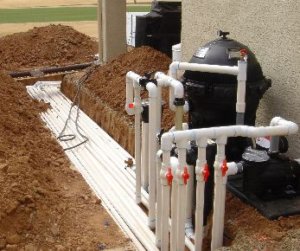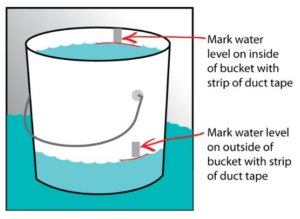FREE Standard Shipping On All Orders $100 or More!*
How to Build a Pool Plumbing Pressure Testing Stick

When new in-ground pools are built, there comes a day when the plumbing crew rolls in and lays neat rows of PVC pipes into a trench. These pipes connect your pool with the pump and filter, pool cleaner, and maybe a waterfall or spa.
The final step before the trench is backfilled is to pressure test the plumbing to make sure that all the glue joints are good, and no cracked pipes exist. The plumber is careful to pressure test thoroughly and present a report to the general contractor so that he doesn't get blamed for damage to the pipes after he leaves.
This blog post is about how to build a homemade pressure tester stick that you can use to pressure test new or old plumbing. Think that your skimmer has a leak? Maybe the main drain? You can test all lines to and from the pool with our simple design. Note that we don't sell this pool plumbing pressure tester, but you can make one yourself with a few simple parts.
Pool Pressure Test Stick
Materials Needed:
- 3 feet of 1.5-inch PVC pipe
- 1.5-inch PVC SxS cap
- 1.5-inch x 1.5-inch x 3/4-inch reducing tee
- 1.5-inch male adapter
- 1.5-inch x 2.0-inch threaded reducer
- 0-60 psi pressure gauge
- Male x female hose valve
- 1/8-inch threaded air valve (pptional)
All of these items can be found at Home Depot or at a plumbing supply company.
Just glue the materials together with PVC glue and you are ready to test your underground plumbing lines for leaks or pressure loss.
Some folks looking for a leak in a pool will use a different type of pressure-testing device, one that will also allow them to use air from a small compressor.
Using air makes it easier to "hear" a pool leak, if you are using listening devices, to pinpoint the exact location of a leak along the line.
This pool pipe pressure tester uses only water, but you could insert an air valve into the air bleeder hole (upper left) so you can also pressurize with air, if desired.
How Does It Work?
Connect a garden hose to the green valve, while the pressure tester stick is firmly threaded into a skimmer. From the starting skimmer, you can isolate certain lines, one at a time, pressurizing the line for 5-10 minutes, while you watch the pressure gauge. No pressure drop, no leak!
You can use these types of pool pressure testing devices to verify the integrity of new or old plumbing, or if you are trying to find the source of a leak in your own pool.
Is Your Pool Leaking?
Before running out to buy these materials to pressure test your whole pool to find a pool leak, first check the basic sources of pool leaks: where the skimmer meets the edge of the pool, or the underwater light, or small cracks in plaster or tears in vinyl. Check that your backwash line is not leaking. Check the pump and filter carefully. Check for cracks in the tile line.
To determine how much of your water loss could be simply evaporation, do the bucket test.

Place a bucket of water on the top step or swim out of the pool. Mark the water level on both the inside and the outside of the bucket, as shown in the image. Shut off the pool pump for 24 hours and if the pool has lost more water than the bucket, then you have a leak in your pool. Repeat the exercise with the pump on for 24 hours. This can give an indication of whether the leak is suction side or pressure side. Next step would be to plug the lines, skimmers, returns, and cleaner line for 24 hours (pump is off). Use threaded or rubber expansion plugs and see how much the pool leaks with all the plumbing (except for the main drain) plugged securely.